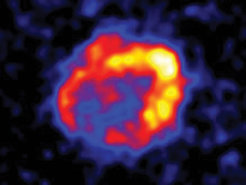The Universe as a physics laboratory
By observing light emitted over the past 13.7 billion years, astronomers and astrophysicists can study our cosmic origins.
By observing light emitted over the past 13.7 billion years, astronomers and astrophysicists can study our cosmic origins. Incredibly, 96% of the Universe is unobservable: made of mysterious dark entities that apparently defy both observation and fundamental physics. A phalanx of powerful new telescopes, combined with our ability to detect gravitational radiation, is set to make the next decade significant in the history of astronomy.
It is 400 years since humans first explored the Universe using more than the naked eye. What began with the modest magnification of visible light by Galileo Galilei’s telescopes, which helped oust the geocentric view, has transformed into a vista spanning 18 orders of magnitude of the electromagnetic spectrum: ranging from the 13.7 billion-year-old microwave radiation produced when the first atoms formed, to the short-wave γ-rays emitted by extreme events in the centres of distant galaxies.
This relentless technological progress has given astronomers a wealth of knowledge about the Sun, the planets and their moons, comets and asteroids, extrasolar planets, stars, galaxies and black holes. It has also allowed investigation of some of civilization’s oldest and deepest questions, such as how the Universe began and how it might end. Yet the closer we look, the more puzzles we find.
DARK ORIGINS
Perhaps the most astounding realization of the past two decades is that 96% of the Universe is composed of dark matter, which does not emit or absorb electromagnetic radiation, and dark energy that is causing the expansion of the Universe to accelerate. Neither of these invisible entities fits current understanding of fundamental physics; however, major observational and experimental programmes such as the Fermi satellite, the earthbound Square Kilometre Array (SKA) and EUCLID will help clarify their nature by revealing their effect on ordinary matter.

The 4% of the Universe that is observable via electromagnetic radiation also offers plenty of mystery. Most of the chemical elements that comprise the planets and life on Earth were forged in the extreme conditions within stars, before being thrown into interstellar space during supernovae explosions; however, how these stars are born and die, and how galaxies evolve, are poorly understood. By combining large-scale numerical simulations with infrared observations of ancient objects — such as those made by the recently launched Herschel Space Observatory and the Institute for Radio Astronomy in the Millimeter Range (IRAM) 30 m telescope and interferometer — scientists hope to understand stellar evolution at different cosmic epochs, as well as from where and what the Earth evolved.
Observations of our nearest star, the Sun, over the past decade have revealed it to be surprisingly dynamic, with ramifications for our global climate. Missions such as the Solar Dynamic Observatory and Solar Orbiter will use helioseismology to probe the processes in the Sun’s interior and the corresponding activity in the solar atmosphere that affect our environment. Astronomers have recently identified more than 400 planets orbiting other stars, with the attendant possibility of extraterrestrial life. Using the next generation of infrared instruments at the European Extremely Large Telescope, radio facilities such as the Atacama Large Millimeter/submillimeter Array (ALMA) and the SKA, and spectroscopy aboard the James Webb Space Telescope (JWST), we expect to detect young exo- planets in their formation stage and thereby shed light on how our planetary system came into being.
